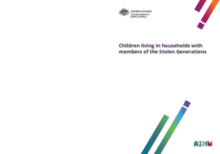Summary
Aboriginal and Torres Strait Islander people who are members of the Stolen Generations (people who were forcibly removed from their families as a result of government policies across Australian jurisdictions) are recognised as experiencing worse outcomes in a range of areas, including health, socioeconomic, justice and housing, compared with other Aboriginal and Torres Strait Islander people who were not removed from their families.
This report provides a new perspective on the intergenerational impact of removal, by looking at outcomes for Aboriginal and Torres Strait Islander children aged under 15 who live in households with members of the Stolen Generations.
It examines 20 selected outcomes for children in 5 broad areas, including health, life stressors, school attendance, language and culture, and some household measures. Comparisons are made on these outcomes between children who live in households with members of the Stolen Generations and other Aboriginal and Torres Strait Islander children in households with adults of the same age who were not removed from their families.
Survey information about both the adults and children is also used to analyse the role of family characteristics, such as education level, employment status and any history of contact with the justice system, on child outcomes. These characteristics have all been shown to influence child development, health and wellbeing among Aboriginal and Torres Strait Islander children (for example, Anderson et al. 2017; AIHW 2015; Guthridge et al. 2016; Kikkawa 2015).
The Australian Bureau of Statistics carries out a series of Indigenous-specific surveys that collect data on a sample of both the children and adults who live in the same household. In this report it is the first time children included in these surveys have been connected to adults in the same household who were removed from their families to uncover direct evidence of the intergenerational effects of removal. In general, children living in these households were more likely to experience a range of adverse outcomes than other Aboriginal and Torres Strait Islander children. This report demonstrates a transfer of intergenerational poverty and trauma.

